Dulce de Leche: The Sweet Treat of Argentina
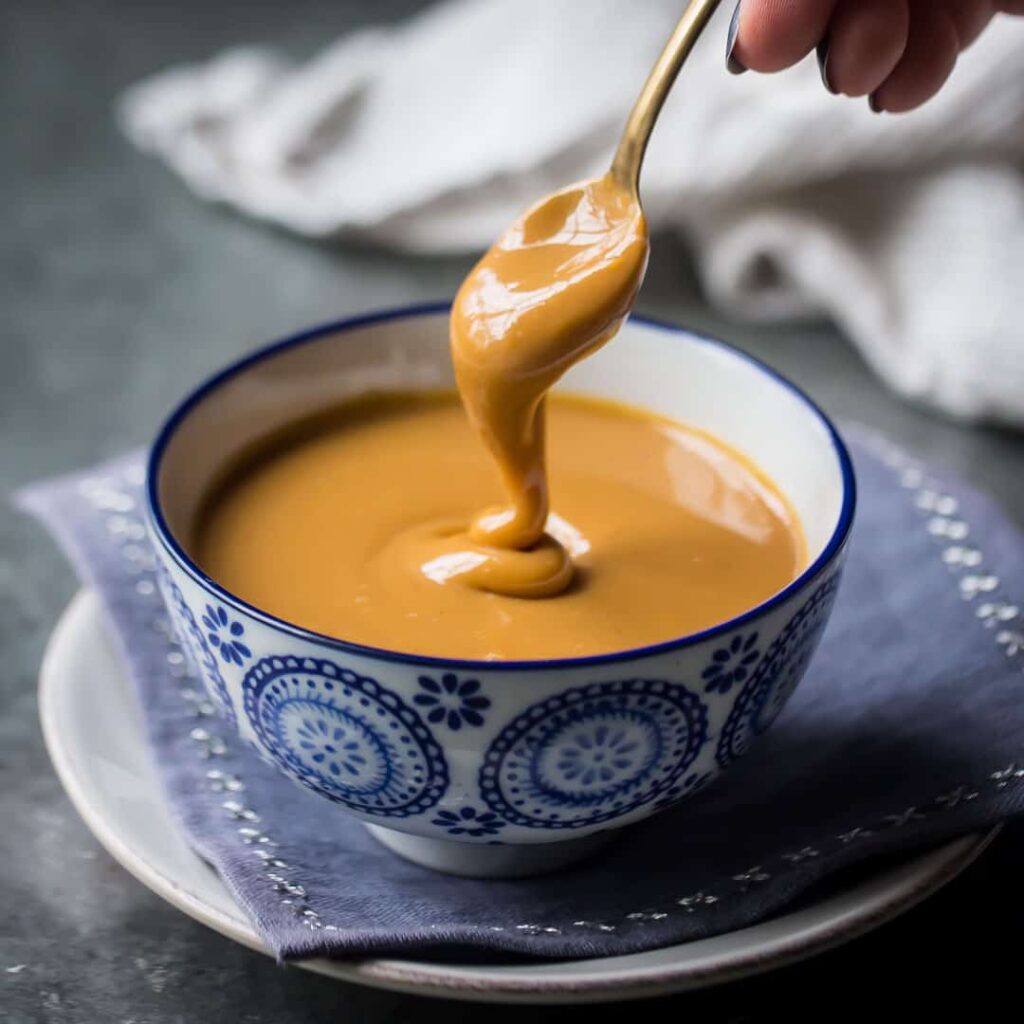
Dulce de leche is a thick, sweet, caramel-like spread that is a beloved staple of Argentinean cuisine. This delicious treat is made by slowly heating sweetened milk until it thickens and develops a rich, caramel-like flavor. In this blog post, we will explore the history of dulce de leche, as well as provide a recipe for you to try at home. History of Dulce de Leche Dulce de leche is believed to have originated in Argentina in the early 19th century. It was created by accident when a cook left a pot of sweetened milk on the stove for too long. The milk caramelized and thickened into a delicious, sweet spread. Dulce de leche quickly became a popular treat in Argentina and soon spread to other countries in South America. Today, dulce de leche is a beloved staple of Argentinean cuisine. It is used in a variety of dishes, including cakes, cookies, and ice cream. It is also often spread on toast or crackers as a simple, delicious snack. Dulce de Leche Recipe Dulce de Leche Ingredients: Dulce de Leche Instructions: Dulce de Leche Cooking Time The cooking time for dulce de leche can vary depending on the method you choose. The oven method, as described in the recipe above, takes approximately 1 1/2 to 2 hours. Other methods, such as using a slow cooker or stovetop, can take anywhere from 4 to 8 hours. Tips for Making Dulce de Leche Conclusion Dulce de leche is a delicious, sweet treat that is a beloved staple of Argentinean cuisine. Whether you use it as a spread, a topping, or an ingredient in your favorite dessert, dulce de leche is sure to satisfy your sweet tooth. So why not try making it at home and experience the delicious taste of Argentina for yourself? More Latin American Recipes More Argentinian Recipes Follow Us on Instagram
Chimichurri: The Iconic Sauce of Argentina

Chimichurri is a sauce that has become synonymous with Argentinean cuisine. This tangy, herb-based sauce is traditionally served with grilled meats, but can also be used as a marinade or dipping sauce. In this blog post, we will explore the history of chimichurri, as well as provide a recipe for you to try at home. History of Chimichurri The origins of chimichurri are somewhat unclear, but it is widely believed to have originated in Argentina. There are several stories about where the name “chimichurri” comes from. One story suggests that it is a corruption of the English phrase “give me curry,” which was supposedly shouted by British soldiers stationed in Argentina who were looking for a spicy sauce to accompany their meals. Another theory is that it comes from the Basque word “tximitxurri,” which means “a mixture of several things in no particular order.” Regardless of its origins, chimichurri has become an integral part of Argentinean cuisine. It is a staple at asados (barbecues) and is often served with steak, chorizo, or other grilled meats. Chimichurri has also gained popularity outside of Argentina and can now be found on menus in restaurants all over the world. Chimichurri Recipe Chimichurri Ingredients: More Latin American Recipes More Argentinian Recipes Follow Us on Instagram
Carbonada: A Traditional Stew from Argentina
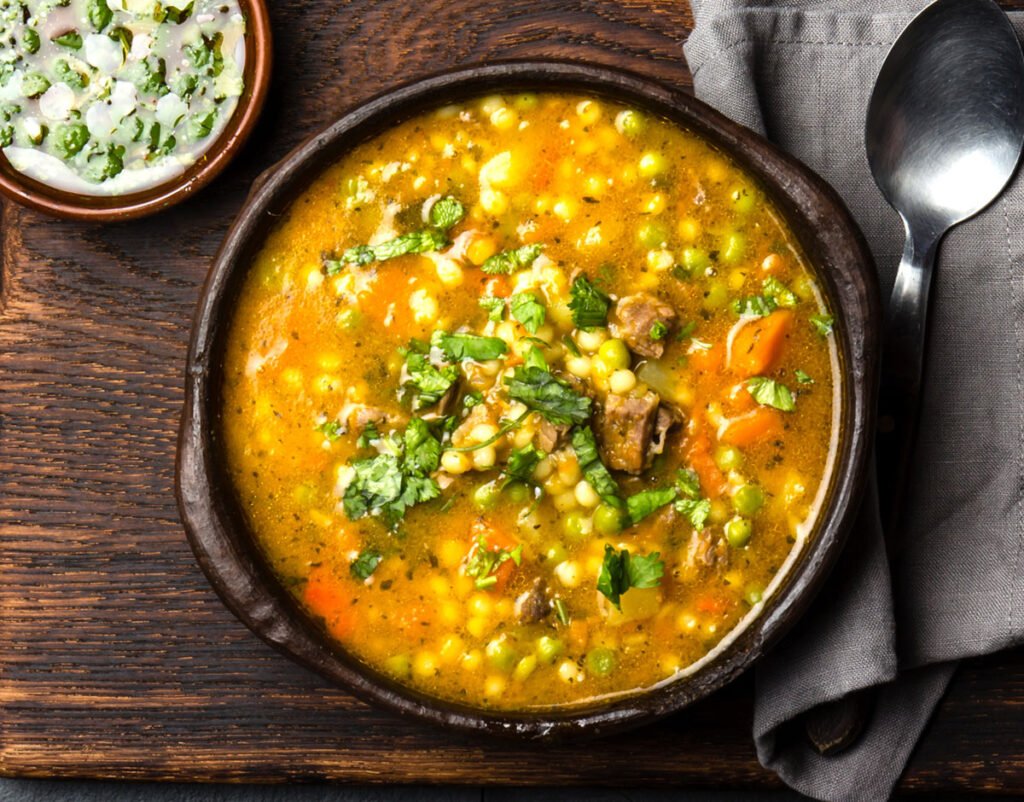
Carbonada is a hearty stew that has been enjoyed in Argentina for generations. This traditional dish is made with beef, vegetables, and a variety of spices, making it a perfect comfort food for a cold winter day. In this blog post, we will explore the history of carbonada, as well as provide a recipe for you to try at home. History of Carbonada The origins of carbonada can be traced back to the indigenous people of Argentina. They would use locally available ingredients such as squash, corn, and beef to create a stew that would sustain them during the harsh winters. The Spanish later arrived in Argentina and brought with them their own culinary traditions, which were merged with the indigenous cuisine to create what is now known as carbonada. Carbonada Recipe Carbonada Ingredients: Carbonada Cooking Time: Carbonada Instructions: Carbonada Recipe Tips: Conclusion Carbonada is a traditional stew from Argentina that is perfect for a cold winter day. With its hearty combination of beef, vegetables, and spices, it’s a meal that will warm you up from the inside out. Whether you’re in Argentina or making it at home, carbonada is a delicious and satisfying dish that’s sure to please. Try this recipe and see for yourself why carbonada is such a beloved part of Argentinean cuisine. More Latin American Recipes More Argentinian Recipes Follow Us on Instagram
Milanesa: A Classic Dish from Argentina

If you’ve ever traveled to Argentina or dined in an Argentinean restaurant, you may have come across milanesa. This popular dish is a staple of Argentinean cuisine and can be found on many menus throughout the country. In this blog post, we will explore the history of milanesa, as well as provide a recipe for you to try at home. History of Milanesa Milanesa is believed to have originated in Italy and was brought to Argentina by Italian immigrants in the late 19th and early 20th centuries. The dish is similar to the Italian dish of “cotoletta alla milanese,” which is a breaded veal cutlet. In Argentina, milanesa is typically made with beef, although chicken and pork versions can also be found. The dish has become a beloved part of Argentinean cuisine and is enjoyed by people of all ages. Milanesa Recipe Milanesa Ingredients: Milanesa Cooking Time: Milanesa Instructions: Conclusion Milanesa is a classic dish from Argentina that has become a beloved part of the country’s cuisine. With its crispy breaded exterior and tender meat interior, it’s easy to see why it’s so popular. Whether you’re in Argentina or making it at home, milanesa is a delicious and satisfying meal that’s perfect for any occasion. Give it a try and see for yourself! More Latin American Recipes More Argentinian Recipes Follow Us on Instagram
Alfajores: A Sweet Delight from Argentina

If you have a sweet tooth, chances are you’ve heard of alfajores. These delicious treats are a staple in Argentina and are enjoyed by people all over the world. In this blog post, we will delve into the history of alfajores, as well as provide a recipe for you to try at home. History of Alfajores The origin of alfajores is unclear, but it is believed that they were introduced to Argentina by the Spanish colonizers. Alfajores were originally made with almonds, honey, and flour, but over time the recipe was adapted to include local ingredients such as dulce de leche, coconut, and cornstarch. Alfajores can be found all over Argentina, from small bakeries to street vendors. They come in many varieties, such as chocolate-covered, coconut-covered, and even savory versions with ham and cheese. Alfajores Recipe Alfajores Ingredients: Alfajores Cooking Time: Alfajores Instructions: Conclusion Alfajores are a delicious and versatile treat that can be enjoyed by anyone with a sweet tooth. With their rich history and many variations, it’s easy to see why they are such a beloved part of Argentinean culture. Whether you’re in Argentina or making them at home, be sure to give alfajores a try! More Latin American Recipes More Argentinian Recipes Follow Us on Instagram
The Ultimate Guide to Mexican Fajitas: Recipes, Cooking Tips, and More
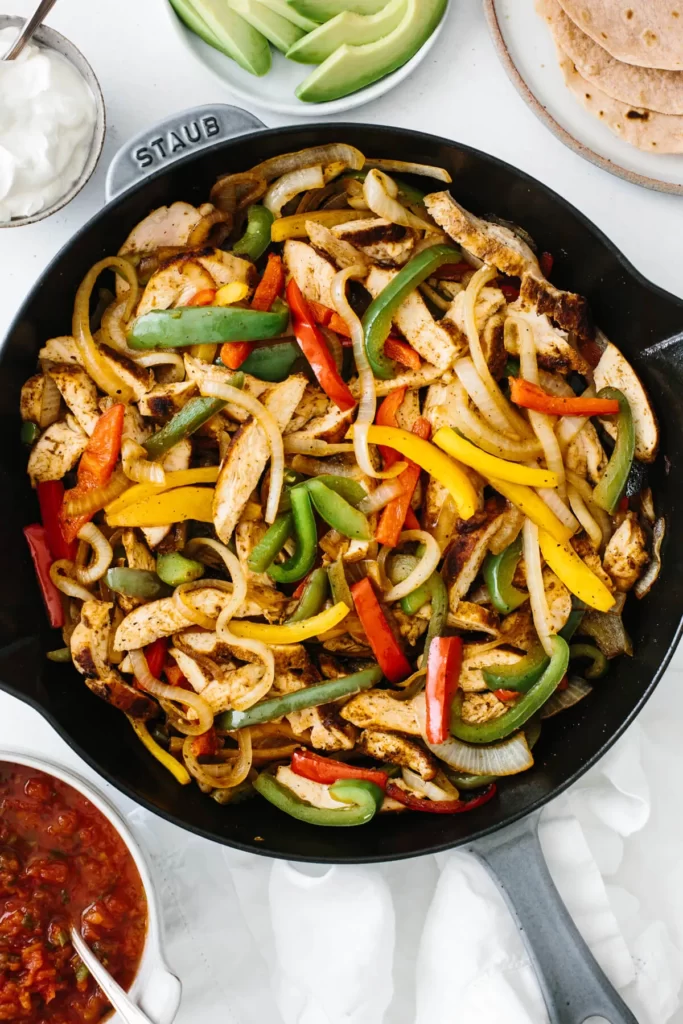
Mexican fajitas are a popular and delicious dish that originated in the border states of Texas and Mexico. Fajitas are typically made with grilled or sautéed strips of marinated beef or chicken, and served with sizzling onions and bell peppers on a warm tortilla. This dish is easy to prepare and is perfect for a quick and flavorful weeknight dinner or a casual gathering with friends and family. In this post, we’ll dive deeper into the history of fajitas, the key ingredients, and the cooking techniques required to make a perfect batch of fajitas. History of Mexican Fajitas The origins of fajitas are somewhat unclear, but it’s believed that the dish was developed by Mexican cowboys or vaqueros in the 1930s. These cowboys were given the tougher cuts of meat, such as skirt steak, which were often discarded by the ranchers. To make the meat more tender, the cowboys would marinate it in lime juice and other seasonings, and then cook it over an open flame. The sizzling sound of the meat as it cooked led to the dish being called “fajitas,” which means “little strips” in Spanish. In the 1960s and 1970s, fajitas gained popularity in the United States, particularly in Texas, where they were served in Mexican restaurants and as a casual street food. Today, fajitas are a staple on menus across the country and have become a beloved dish in Mexican and Tex-Mex cuisine. Ingredients for Mexican Fajitas The key ingredients for Mexican fajitas are strips of beef or chicken, onions, bell peppers, and tortillas. Other ingredients can be added to customize the dish to your liking, such as cheese, salsa, guacamole, and sour cream. Here’s a breakdown of the main ingredients: Recipe for Mexican Fajitas Here’s a simple recipe for beef fajitas that serves four people: Mexican Fajitas Ingredients Mexican Fajitas Instructions Conclusion Mexican fajitas are a flavorful and easy-to-prepare dish that is perfect for a quick weeknight dinner or a casual gathering with friends and family. The key ingredients of fajitas are beef or chicken, onions, bell peppers, and tortillas, and there are endless variations to customize the dish to your liking. By following a few simple cooking tips, you can make a perfect batch of fajitas that will be sure to please everyone at the table. More Latin American Recipes More Mexican Recipes Follow Us on Instagram
Authentic and Delicious Chilaquiles Recipe: A Classic Mexican Dish for Any Mealtime
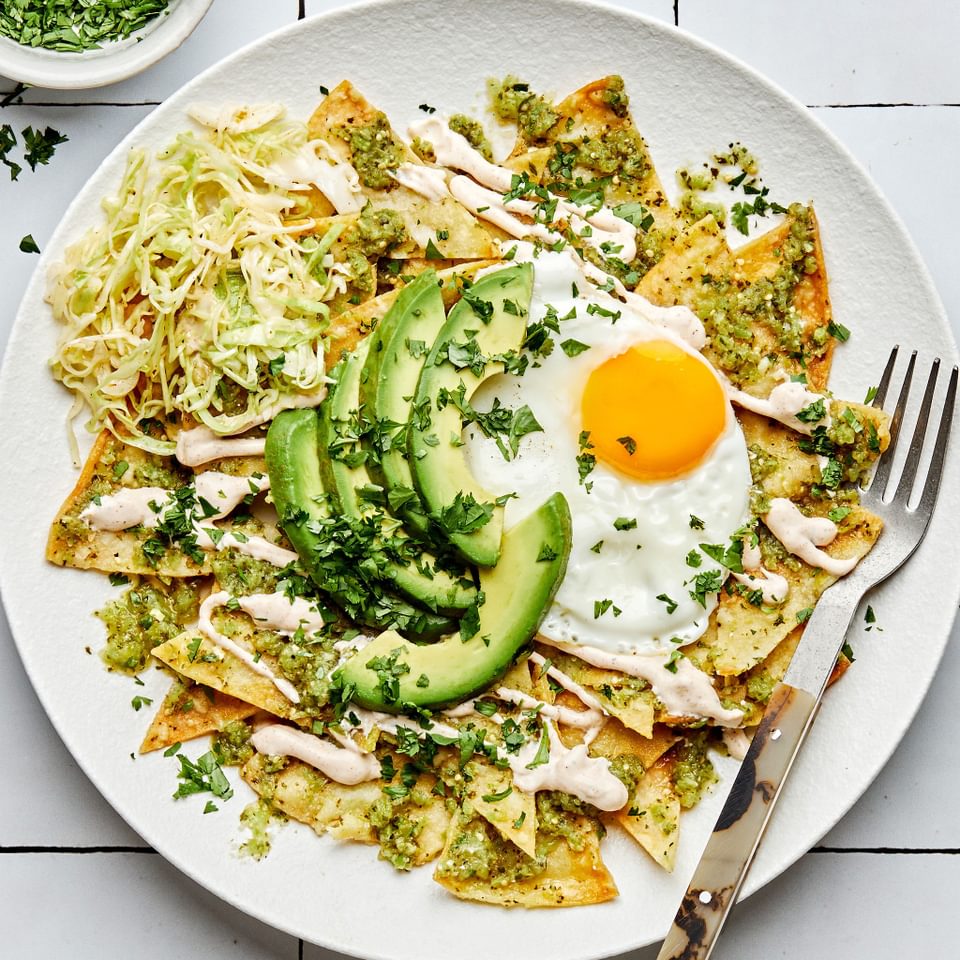
If you’re looking for a traditional Mexican breakfast dish that is hearty, flavorful, and easy to prepare, then chilaquiles is a great option. Chilaquiles is a dish made from fried tortillas that are simmered in a spicy tomato sauce and topped with a variety of ingredients, including eggs, cheese, and avocado. In this post, we’ll explore the history of chilaquiles, provide a step-by-step recipe for making this delicious dish, and offer some tips for cooking the perfect batch of Mexican chilaquiles. History of Mexican Chilaquiles Chilaquiles has a long history in Mexico and is considered a traditional breakfast dish in many regions. The dish is believed to have originated in pre-Columbian times, when people would fry stale tortillas to make them more palatable. Over time, the dish evolved to include a variety of sauces and toppings, including eggs, cheese, and meat. Recipe for Mexican Chilaquiles Here is a simple recipe for making traditional Mexican chilaquiles: Ingredients for Mexican Chilaquiles Instructions for Mexican Chilaquiles Cooking Tips for Mexican Chilaquiles Here are a few tips to help you make the perfect batch of Mexican chilaquiles: Conclusion Chilaquiles are a classic Mexican dish that can be enjoyed for breakfast, lunch, or dinner. This simple recipe uses a homemade tomato sauce that is easy to make and deliciously flavorful. Baked tortilla chips are coated in the sauce and then topped with cheese and fresh cilantro for a satisfying and delicious meal. Whether you prefer them as a snack, appetizer, or main course, chilaquiles are a versatile and delicious addition to any meal. Try this recipe today and experience the rich and vibrant flavors of traditional Mexican cuisine. More Latin American Recipes More Mexican Recipes Follow Us on Instagram
Exploring the World of Mexican Mole: A Guide to Traditional Dishes
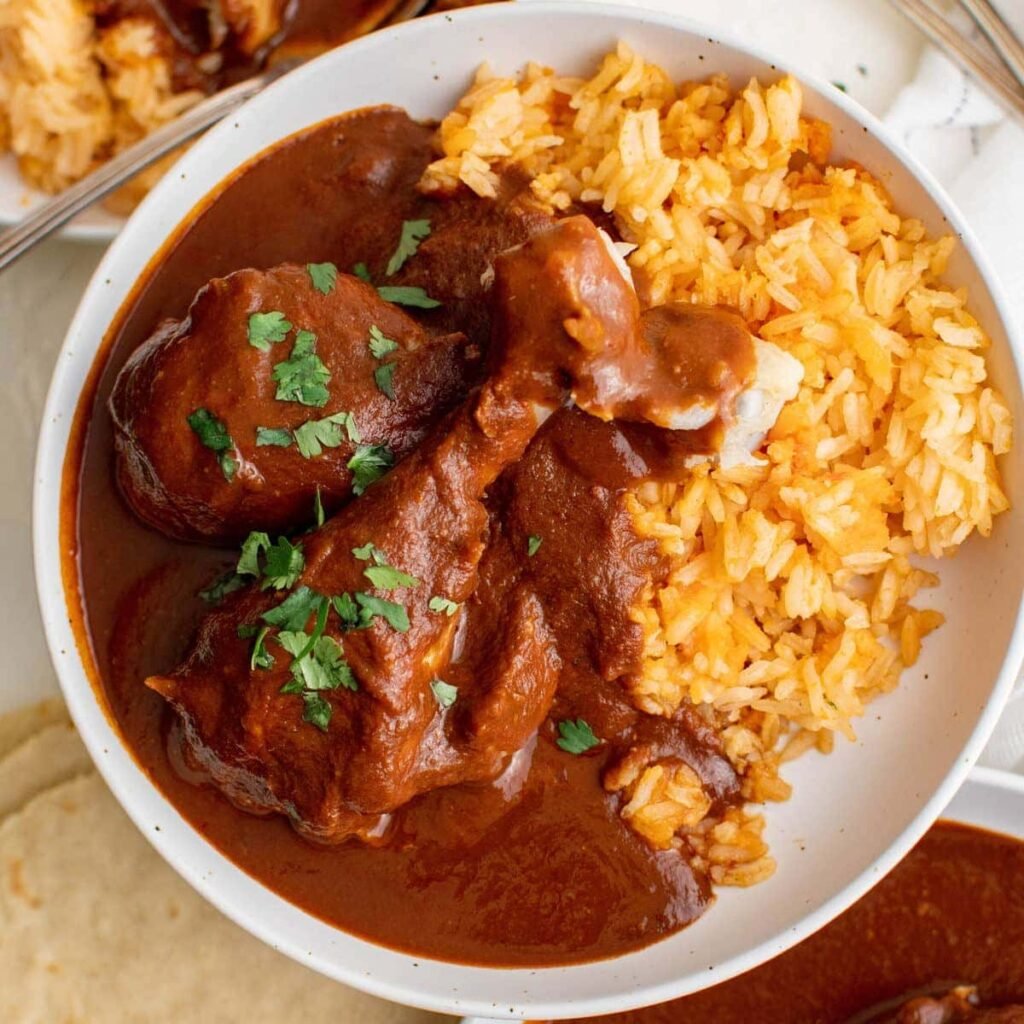
Mexican mole is a traditional and flavorful sauce that is often used in Mexican cuisine. It’s a complex and rich sauce that is made from a variety of ingredients, including spices, herbs, and chiles. Mole is a popular and versatile sauce that can be used in a variety of dishes, including chicken, pork, beef, and even vegetarian options. In this post, we’ll take a closer look at mole, its history, and how to make this delicious sauce at home. History of Mole: The origin of mole is not entirely clear, but it’s believed to have originated in pre-Hispanic Mexico. The Aztecs and Mayans used chiles and cocoa in their cooking, and it’s possible that mole sauce has its roots in these ancient cultures. Over time, mole sauce evolved and became more complex, with additional ingredients like nuts, seeds, and fruits being added to the recipe. Today, mole is a beloved sauce in Mexican cuisine and is often served at special occasions and celebrations. Recipe for Mexican Mole Mole is a complex sauce made with a variety of ingredients, including chilies, spices, nuts, and often chocolate. Here is a basic recipe for mole: Mole Ingredients: Mole Instructions: Cooking Time for Mexican Mole Mexican mole is a time-consuming dish to prepare. The cooking time for this recipe is about 1 hour and 15 minutes, including preparation time. Conclusion Mole is a flavorful and complex sauce that is a staple in Mexican cuisine. Its unique combination of spices, chilies, and chocolate gives it a rich, earthy flavor that pairs well with a variety of dishes. While it can be time-consuming to prepare, the end result is well worth the effort. Whether you’re using it as a sauce for chicken, enchiladas, or tamales, mole is sure to add a delicious and unique flavor to your meals. More Latin American Recipes More Mexican Recipes Follow Us on Instagram
Mexican Chiles Rellenos: A Guide to the Classic Stuffed Peppers

Mexican cuisine is known for its bold and complex flavors, and one dish that perfectly embodies these qualities is chiles rellenos. This traditional dish features large, mild peppers that are stuffed with a savory filling, then coated in a light batter and fried to crispy perfection. Whether you’re a fan of spicy foods or prefer milder flavors, chiles rellenos are sure to satisfy your taste buds. In this post, we’ll explore the origins of this classic dish and provide step-by-step instructions for making it at home. Chiles Rellenos History and Origin Chiles rellenos have a long and rich history in Mexican cuisine. The dish is believed to have originated in the city of Puebla, in central Mexico, during the colonial period. The Spanish introduced peppers to the indigenous people of Mexico, who then adapted them to their own culinary traditions. Chiles rellenos quickly became a popular dish, with many variations and regional styles developing over time. Today, chiles rellenos remain a staple of Mexican cuisine, and are enjoyed in many different forms throughout the country. While the basic recipe remains the same, there are countless variations on the filling and sauce used to make this delicious dish. Recipe for Chiles Rellenos Chiles Rellenos Ingredients: Chiles Rellenos Cooking time: Preparation time: 30 minutes Cooking time: 30 minutes Total time: 1 hour Chiles Rellenos Instructions: Chiles Rellenos Tips and Variations Chiles rellenos can be customized to your liking by using different fillings and sauces. Here are a few ideas to get you started: Chiles Rellenos Cooking Instructions Conclusion Chiles rellenos are a classic Mexican dish that is both flavorful and satisfying. While they may require a bit of effort and skill to prepare, the end result is well worth it. Whether you prefer them stuffed with cheese, meat, or vegetables, these delicious peppers are sure to impress your family and friends. So why not give them a try and see for yourself? More Latin American Recipes More Mexican Recipes Follow Us on Instagram
Mexican Salsa: A Delicious and Versatile Condiment
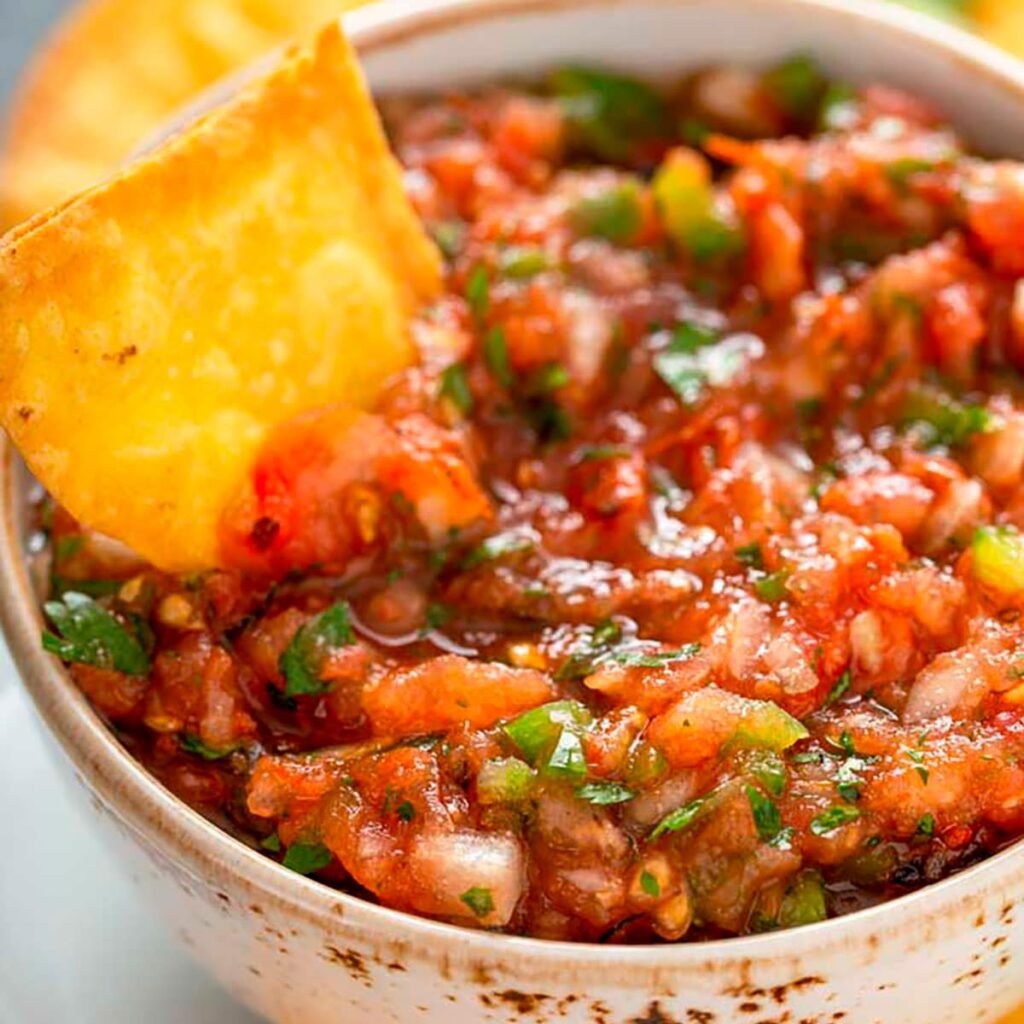
Salsa is a traditional Mexican condiment that has become a staple in many kitchens around the world. This spicy and flavorful sauce can be used as a dip for tortilla chips, a topping for tacos and burritos, or as a marinade for meats and vegetables. In this article, we’ll explore the history of Mexican salsa, the different types of salsa, and how to make it at home. History of Mexican Salsa Salsa has been a part of Mexican cuisine for centuries, with the first recorded salsa recipe dating back to the Aztecs. The Aztecs made their salsa using tomatoes, chili peppers, and ground squash seeds, which they ground together using a stone mortar and pestle. Salsa has since evolved to include a wide variety of ingredients, including onions, garlic, cilantro, lime juice, and a variety of different peppers. Types of Mexican Salsa There are many different types of Mexican salsa, each with its own unique flavor and texture. Here are some of the most popular types: Pico de Gallo: Also known as salsa fresca, pico de gallo is a fresh and chunky salsa made with diced tomatoes, onions, and peppers, along with cilantro and lime juice. This type of salsa is often served as a topping for tacos, burritos, and other Mexican dishes. Salsa Roja: Salsa roja, or red salsa, is a cooked salsa made with tomatoes, onions, garlic, and a variety of different peppers, including chipotle, ancho, and guajillo. This type of salsa is often used as a topping for enchiladas and other Mexican dishes. Salsa Verde: Salsa verde, or green salsa, is made with tomatillos, a type of small green tomato with a tart flavor. This salsa is often used as a dip for tortilla chips or as a topping for tacos and burritos. Chipotle Salsa: Chipotle salsa is made with chipotle peppers, which are smoked and dried jalapeno peppers. This type of salsa has a smoky and spicy flavor and is often used as a marinade for meats and vegetables. How to Make Mexican Salsa Here is a simple recipe for making a classic Mexican salsa: Mexican Salsa Ingredients: Mexican Salsa Instructions: Mexican Salsa Cooking Time The cooking time for Mexican salsa varies depending on the type of salsa being made. Some salsas, like pico de gallo, are made fresh and require no cooking time. Other salsas, like salsa roja, require cooking the ingredients on the stove for at least 15-20 minutes to allow the flavors to meld together. Overall, making salsa is a quick and easy process that can be done in under 30 minutes. Tips for Making Mexican Salsa Here are a few tips for making a delicious Mexican salsa: More Latin American Recipes Follow Us on Instagram
